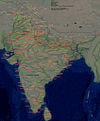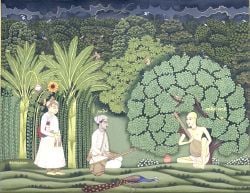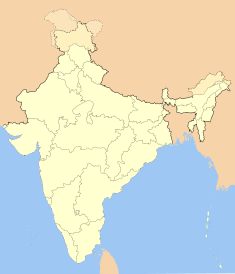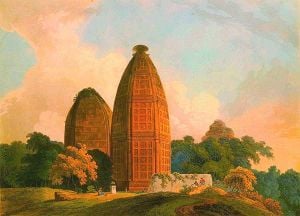Vrindavan
| Vrindavan Uttar Pradesh • India | |
| Coordinates: | |
| Time zone | IST (UTC+5:30) |
| Area • Elevation |
• 170 m (558 ft) |
| District(s) | Mathura |
| Population | 56,618 (2001) |
Coordinates: Vrindavan pronunciation ▶ (alternate spellings Vrindaban or Brindavan or Brundavan), or Vraj in Mathura district, Uttar Pradesh, India is a town on the site of an ancient forest believed to have been the region where the famous cowherd boy, Krishna, from Hindu scriptures spent his childhood days. It lies in the Braj region fifteen kilometers from Mathura city (said to be Krishna's birthplace), near the Agra-Delhi highway. The town includes many hundreds of temples dedicated to the worship of Radha and Krishna, considered sacred by numerous religious traditions including Gaudiya Vaishnavism, Vaishnavism, and Hinduism in general.
In the past, Vrindavan had the most beautiful of forests in India (Kalidas). During past 250 years it has been subjected to urbanization first by local Rajas and in recent decades by apartment building developers. As of 2008, forest in the area have become meager and the local wildlife, including peacocks, cows, monkeys and a variety of bird species have been greatly reduced and in danger of extinction. A few Peacocks and many monkeys range freely but cows mainly inhabit the gosalas of all the major Ashrams of Vrindavan.
History
The ancient name of the city, 'Brindaban', had been named after its ancient groves of 'Brinda' Ocimum tenuiflorum or Tulsi with ban meaning a grove or a forest [1]. Two small groves still exist, Nidhivan and Seva kunj Vrindavan has played an important part in Hindu folklore since ancient time and serves as a sacred Hindu pilgrimage site. One of its oldest surviving temples, the Govind Deo temple, had been built in 1590 with Brindaban becoming Vrindavan earlier in the same century [2].
Religious heritage
All traditions of Hinduism consider Vrindavan a holy site. Vaisnavisisim constitutes the major tradition followed in Vrindavan which serves as a center of learning with many Ashrams. It serves as a center of Krishna worship, with places like Govardhana and Gokula associated with Krishna from the beginnings of Hinduism. Many millions of bhaktas, or devotees of Radha Krishna, make pilgrimage every year and participate in a number of festivals that relate to the scenes from Krishna's life. [3]

According to tradition and recorded evidence, Krishna was raised in the cowherding village of Gokul by his foster parents Nanda Maharaj and Yasoda. The Bhagavata Purana describes Krishna's early childhood pastimes in Vrindavan forest wherein he, his brother Balarama, and his cowherd friends stole butter, engaged in childhood pranks and fought with demons. Along with these activities, Krishna is also described as meeting and dancing with the local girls of Vrindavan village (and especially Radharani) who were known as gopis. These pastimes were the source of inspiration for the famous Sanskrit poem, Gita Govinda, by the Orissan poet, Jayadeva (c. 1200 C.E.).
Temples
The most popular temples include:
- The Madan Mohan Temple located near the Kali Ghat which was built by Kapur Ram Das of Multan. This is the oldest existent temple in Vrindavan today. The temple is closely associated with the saint Chaitanya Mahaprabhu. The original image of Lord Madan Gopal was shifted from the shrine to Karauli in Rajasthan for safe keeping during Aurangzeb's rule. Today, a replica of the image is worshiped at the temple.
- The Banke Bihari Temple, built in 1862[4] is the most popular shrine at Vrindavan. The image of Banke-Bihari was discovered in Nidhi Vana by Swami Haridas, the great Krishna devotee, belonging to the Nimbarka sampradaya.
- The famous Radha Vallabh Temple set up by the Radha-Vallabh sampradaya, through Sri Hith Harivansh Mahaprabhu[5], has the crown of Radharani placed next to the Shri Krishna image in the sanctum.
- The Jaipur Temple which was built by Sawai Madho Singh II, the Maharaja of Jaipur in 1917, is a richly embellished and opulent temple. The fine hand - carved sandstone is of unparalleled workmanship. The temple is dedicated to Shri Radha Madhava.
- Sri Radha Raman Mandir constructed at the request of Gopala Bhatta Goswami around 1542 is one most exquisitely crafted and revered temples of Vrindavan, especially by the Goswamis. It still houses the original saligram deity of Krishna, alongside Radharani.[6]
- The Shahji Temple, another popular temple at Vrindavan, was designed and built in 1876 by a wealthy jeweller, Shah Kundan Lal of Lucknow. The deities (images) at the temple are popularly known as the Chhote Radha Raman. Noted for its magnificent architecture and beautiful marble sculpture, the temple has twelve spiral columns each 15 feet high. The `Basanti Kamra' - the darbar hall is famed for its Belgian glass chandeliers and fine paintings.
- The Rangaji Temple, built in 1851 is dedicated to Lord Ranganatha or Rangaji depicted as Lord Vishnu in his sheshashayi pose, resting on the coils of the sacred Sesha Naga. The temple built in the Dravidian style (as a replica of Srivilliputhur) has a tall gopuram (gateway), of six storeys and a gold - plated Dhwaja stambha, 50 feet high. A water tank and a picturesque garden lie within the temple enclosure. The annual festival of Jal Vihar of the presiding deity is performed with great pomp and splendour at the tank. The temple is also famous for its `Brahmotsdav' celebration in March-April, more popularly known as the `Rath ka Mela'. The ten day long celebrations are marked by the pulling of the rath (the chariot car) by the devotees from the temple to the adjoining gardens. The prayers within the temple are performed, following in the style of Andal, one of the twelve Vaishnava Saints of South India.
- The Govind Deo (Govindaji) Temple was once a magnificent seven storeyed structure built in the form of a Greek cross. It is said that the Emperor Akbar donated some of the red sandstone that had been brought for the Red Fort at Agra, for the construction of this temple. Built at the astronomical cost of one crore rupees in 1590 by his general Raja Man Singh, the temple combines western, Hindu and Muslim architectural elements in its structure. It was destroyed by Mughal ruler Aurangzeb.
- The Sri Krishna-Balrama Temple built by the International Society for Krishna Consciousness (ISKCON) in a location known as 'Raman-Reti', is one of the most beautiful temples in Vrindavan today. The principal deities of this temple are Krishna & Balaram, with Radha-Shyamasundar and Gaura-Nitai alongside. Adjoining the temple is the samadhi of A. C. Bhaktivedanta Swami Prabhupada, the founder of ISKCON, built in pure white marble.
- The Radha Damodar Mandir Located at Seva Kunj, the Mandir was established in 1542 by Srila Jiva Goswami. The deities Sri Sri Radha Damodar are here. The bhajan kutir of A. C. Bhaktivedanta Swami Prabhupada is also situated at the Mandir.
Other sacred sites

Other places of interest include Seva Kunj, Kesi Ghat, Sriji Temple, Jugal Kishore Temple, Lal Babu Temple, Raj Ghat, Kusuma Sarovar, Meera-Bai Temple, Imli Tal, Kaliya Ghat, Raman Reti, Varaha Ghat and Chira Ghat, and across the river, a short boat-ride away is the samadhi shrine of Devraha Baba, a revered saint of the last century.
The Seva Kunj is where Lord Krishna once performed the Raaslila with Radha-Rani and the gopis and Nidhi Van where the divine couple rested. The samadhi of Swami Haridas, the guru of Tansen, is situated here. Every year, in his honour, Swami Haridas Sammelan is organized, in which all renowned musicians of India take part.
Another famous temple of Sri Vrindavan is Sri Kathia Baba Ka Sthan" at Gurukul Road [1], the mahanta of which is entitled as "brajobidehi mahanta" and the acharya of Swabhuram Dwara of Nimbarka sect, Sri Swami Rash Behari Das Kathia Babaji Maharaj.
Demographics
As of 2001 India census, Vrindavan had a population of 56,618. Males constitute 56% of the population and females 44%. Vrindavan has an average literacy rate of 65%, higher than the national average of 59.5%: male literacy is 73%, and female literacy is 55%. In Vrindavan, 13% of the population is under 6 years of age. The number of females is 24,200 including 13% who are under 6 years of age.
Vrindavan is also known as the City of Widows[7] due to the large number of widows who move into the town and surrounding area after losing their husbands. According to some Hindu traditions, upper-caste widows may not remarry, so many of those abandoned by their families on the death of their husband make their way here. There are an estimated 15,000 to 20,000 widows living on the streets[8][9], many of whom have spent over 30 years there. In exchange for singing bhajan hymns for 7-8 hours in bhajanashrams, women are given a cup of rice and a pittance of money (around Rs.10)[7], which they try to supplement by begging on the streets or in some instances, even through prostitution. An organization called Guild of Service was formed to assist these deprived women and children[9]. In 2000 the organization opened Amar Bari (My Home), a refuge for 120 Vrindavan widows, and a second shelter for 500 widows is expected to open.
See Also
- Mirabai
- Vaishnavism
- Nimbarka
- Vallabha
- Religion in India
- Hare Krishna
Notes
- External links in footnotes retrieved November 17, 2008.
- ↑ Brindaban: The Imperial Gazetteer of India, 1909, v. 9, p. 17
- ↑ Brindaban.
- ↑ KLOSTERMAIER, Klaus K. (2007). A Survey of Hinduism. State University of New York Press; 3 edition, p.204. ISBN 0791470814. “The center of Krishna-worship has been for a long time Brajbhumi, the district of Mathura that embraces also Vrindavana, Govardhana, and Gokula, associated with Krishna from the time immemorial.”
- ↑ Banke-Bihari Temple website
- ↑ Radhavallabh Temple website
- ↑ The history of Sri Radha Raman Temple
- ↑ 7.0 7.1 CNN: India's widows live out sentence of shame, poverty. Retrieved 2008-11-17.
- ↑ Catalyst Magazine: Moksha: the widows of Vrindavan. Retrieved 2008-11-17.
- ↑ 9.0 9.1 Shunned from society, widows flock to city to die. Retrieved 2008-11-17. (This article was criticized by several members of the South Asian Journalists Association for "generalizations and questionable assertions." An article in the SAJA Forum documents several instances where, after such criticisms appeared, CNN quietly made changes in the online version of the article. Arun Venugopal, a reporter for WNYC, wrote, "On the SAJA Discussion list, a number of people across the political spectrum found that the story ascribed too much to 'tradition' rather than to more complex social realities.")
ReferencesISBN links support NWE through referral fees
This article incorporates text from the Encyclopædia Britannica Eleventh Edition, a publication now in the public domain.
- Brooks, Charles R. 1989. The Hare Krishnas in India. Princeton, N.J.: Princeton University Press. ISBN 9780691031354.
- Case, Margaret H. 2000. Seeing Krishna: the religious world of a Brahman family in Vrindaban. New York: Oxford University Press. ISBN 9780195130102.
- Corcoran, Maura. 1995. Vṛndāvana in Vaiṣṇava literature: history, mythology, symbolism. Reconstructing Indian history v. ?, no. 6. Vrindaban: Vrindaban Research Institute. ISBN 9788124600245.
- Daljeet. 1999. Krishna, the living spirit of Vrindavan. New Delhi: Aravali Books International. ISBN 9788186880616.
- Das, R. K. 1990. Temples of Vrindaban. Delhi: Sandeep Prakashan. ISBN 9788185067476.
- Klostermaier, Klaus K. 2007. A Survey of Hinduism. State University of New York Press; 3rd ed. ISBN 0791470814.
- Mohana, Anila Krapābhikshu. 1992. Vrandāvana kī kuñja galina men. Naī Dillī: Pravina Prakāśana. OCLC 27014275.
- Rosen, Steven. 1991. The six goswamis of Vrindavan. Brooklyn, N.Y.: Folk Books. ISBN 9780961976323.
- Thielemann, Selina. 1998. Sounds of the sacred: religious music in India. New Delhi: A.P.H. Pub. Corp. ISBN 9788170249900.
External links
All external links retrieved November 17, 2008.
- Sri Vrindavan-dham
- Food for Life Vrindavan
- Friends of Vrindavan
- Mathura & Vrindavan
- Guide tour to Vrindavan and its allied temples
- "Nothing to Go Back To - The Widows of Vrindavan WNN - Nov 5, 2007]
- BBC: More Indians in 'city of widows' Vrindavan
| |||||||||||||
| ||||||||||||||||||||
Credits
New World Encyclopedia writers and editors rewrote and completed the Wikipedia article in accordance with New World Encyclopedia standards. This article abides by terms of the Creative Commons CC-by-sa 3.0 License (CC-by-sa), which may be used and disseminated with proper attribution. Credit is due under the terms of this license that can reference both the New World Encyclopedia contributors and the selfless volunteer contributors of the Wikimedia Foundation. To cite this article click here for a list of acceptable citing formats.The history of earlier contributions by wikipedians is accessible to researchers here:
The history of this article since it was imported to New World Encyclopedia:
Note: Some restrictions may apply to use of individual images which are separately licensed.



